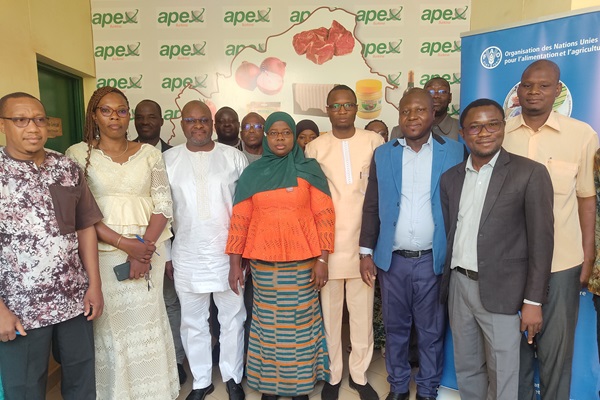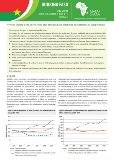Burkina Faso

Agrifood policy monitoring
Actual agriculture-specific expenditures* in Burkina Faso from 2006–2020 stood at an average of USD 174 million, with the lowest of that period being USD 80 million in 2015, the highest being USD 273 million in 2013.
On average in the last 5 years (2016–2020), budgeted amounts stood at USD 309 million, while actual spending at USD 210 million, implying a budget execution rate of 72%.
Burkina Faso’s agriculture expenditure level was below the CAADP 10% target. Between 2006 and 2020, the share of agriculture spending over total public expenditure ranged from the lowest 2.9% in 2010 and the highest 7.9% in 2015, with an annual average over the period of 5.8%.
In the last 5 years, on average, two-thirds (66%) of all expenditures on food and agriculture came from donors, while the rest (34%) was financed by the government.
On average, in the same period, the bulk of actual agriculture-specific expenditures – more than two-thirds (70%) – was directed towards general sector support (i.e. public goods such as research, extension or infrastructure), followed by almost a quarter of spending (23%) targeting producers, mainly in form of input subsidies, around 4% allocated to consumers (through food or subsidies and school-meals programmes), and just 2% to other agents in commodity value chains.
*in USD nominal terms
The nominal rate of protection (NRP) at farm-gate – the ratio of the price gap at farm-gate in relation to the reference price – was 40%, on average and across all 6 commodities: cotton seeds, groundnuts (with shell), maize, rice (paddy), sesame seeds, and sorghum between 2005 and 2020, with the most negative being -60% in 2010 and the most positive 352% in 2008.
There is, however, substantial differences across the five commodities analysed:
- Groundnuts producers benefitted from positive price disincentives on average over the period 2005–2020, as the average NRP at farm-gate (observed) was -4%, with the highest value of 50% in 2019 and the lowest of -56% in 2008.
- Maize producers benefitted from positive price incentives between 2005 and 2020, as the average NRP at farm-gate (observed) was 53%, with the highest value of 351% in 2008 and the lowest -26% in 2006. However, maize producers faced negative price incentives in 3 more years, with a value of -0.7% in 2009, -1.43% in 2013 and -6.87% in 2020.
- Rice producers benefitted from positive price incentives, with the average NRP at farm-gate (observed) at 58% over the period 2005–2020, with the highest value of 133% in 2005 and the lowest value of 33% in 2008.
- Cotton seeds producers benefitted from positive price incentives, with the average NRP at farm-gate (observed) at 36% over the period 2005–2020, with the lowest value of -60% in 2010 and the highest value of 184% in 2008.
- Sesame seeds producers benefitted from positive price incentives between 2005 and 2020 (average NRP was 29%) , with the lowest value of -34% in 2016 and the highest value of 118.72% in 2014 .
- Sorghum producers benefitted from positive price incentives between 2005 and 2020 (average NRP was 67%) , with the lowest value of 10% in 2009 and the highest value of 190% in 2019.
Agrifood policy prioritization
MAFAP conducted a policy optimization study for the Permanent Secretariat for the Coordination of Agricultural Sector Policies to identify agricultural investments options that would have significant effects on key economic outcomes, including agricultural GDP growth, rural poverty, off-farm employment, and agricultural product exports.
The study also identified potential trade-offs involved in such investments and in the policy objectives sought by the government. The results of this economic modelling are included in the introductory document for the États Generaux de l’Agriculture, a major policy dialogue aimed at convening stakeholders to identify key reforms for the sector.
Current agrifood policy support
MAFAP has carried out an analysis for the Agence pour la Promotion des Exportations du Burkina (APEX-Burkina) to prioritize a set of agricultural commodities with a competitive edge and to map out sub-regional, regional and international markets where these exports could bring in higher export earnings for the country.
The results and recommendations were presented in January 2024 during a workshop hosted at APEX-Burkina. Read more on this here and in French here.
The programme is collaborating with the Secrétariat Permanent de la Coordination des Politiques Sectorielles Agricoles to provide the government with a set of key agrifood reforms and investments with policy recommendations on pathways on how to implement the reforms and ways to mobilize financial resources to make them happen.
News

New to the MAFAP team: Clara, Koutou and Nada
15/04/2024

MAFAP delivers results of 16 high-potential commodities to Burkina Faso exports agency
22/01/2024

MAFAP starts a new 5-year phase of agrifood policy monitoring and reform prioritisation in Burkina Faso
10/06/2022
Publications

Vers un soutien de la filière coton plus efficient pour améliorer durablement sa compétitivité
20/09/2013
Regulated cotton prices in Burkina Faso have led to higher domestic prices and incentives to production. Although fixed prices, which are indexed to...

Targeting Public Spending to Expand Export and Marketing Opportunities for Key Commodities in Burkina Faso
26/07/2013
Public expenditure on agriculture and rural development in Burkina Faso has not adequately targeted the main factors which depress producers’ prices...
National partners
- Ministry of Agriculture, Animal Resources and Fisheries
- Secrétariat permanent de la coordination des politiques sectorielles agricoles
- Agence pour la Promotion des Exportations du Burkina
Useful links
Contact the MAFAP Burkina Faso team

Mahamoudou Koutou
Agrifood Policy Specialist

Tebila Nakelse
Senior Policy Advisor

